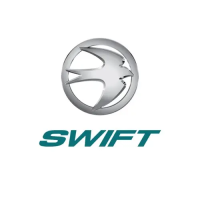TOWING CODE
23
Types of tyres fitted
The original tyres fitted by the manufacturer are
suitable for towing at a maximum speed of up
to 81 mph (130 kph).
Tyres
Caravan manufacturers choose the type,
size, profile, load carrying capacities and
speed ratings to match the design masses
of there vehicles, adjusting the tyre pressures
to suit. Only change the type of tyres on your
caravan on expert advice from the caravan
manufacturer, or tyre manufacturer.
Tyre maintenance
Tread depth
Pay special attention to the amount of tread
remaining on your tyres, and measure them
regularly. Always replace tyres before they
reach the minimum legal limit of 1.6mm.
Periodically tyres should be rotated to equalise
wear in the same manner as car tyres.
Pressures
The caravan manufacturers plate (fixed
adjacent to exterior door) and Technical
handbook contains information about caravan
loading and the required adjustments to
tyre pressures, which should be followed for
safety (these pressures relate only to the tyres
originally fitted to the caravan). Tyre pressures
should always be checked and corrected prior
to each journey. It is vital that tyre pressures
are maintained at the levels recommended by
the manufacturer to ensure maximum tyre life,
safety and handling characteristics.
Over or under-inflating tyres is likely to
seriously impair their performance and may
compromise the safe use of the vehicle.
Over-inflation increases overall tyre diameter,
decreases the amount of tread in contact with
the road, decreases sidewall flexibility and
affects road-adhesion.
Under-inflation decreases overall tyre diameter,
increases sidewall flexing, generates higher
tyre operating temperatures and difficult
vehicle handling characteristics. Running an
under-inflated tyre may cause premature tyre
failure. Both over and under-inflation adversely
affect tyre life.
Tread
Keep tyre treads clean of stones and other
foreign bodies, and check regularly for
damage to the tread and sidewalls. It is vitally
important that any damage is checked out
by a tyre expert and any necessary repairs or
replacements are carried out immediately.
Tyre valves
Check tyre valves carefully. Ensure the caps
are in place free from dirt/ debris and that there
is no evidence of cracking or damage to the
valve stem.
Tyre aging
Rubber compounds used in tyres contain
chemicals that help to slow down the natural
aging process of untreated rubber. However,
tyres do deteriorate with age, which increases
the risk of tyre failure, and there are many ways
in which this can be spotted:
• Cracking/crazing on the side wall of the tyre,
caused by its flexing
• Distortion of tyre tread
• Deformation of the carcass of the tyre
There will also be a deterioration of the ride
quality caused by vibrations through the
tyre. This may signify the tyres performance
has been affected by age and should be
investigated as soon as possible
Note: It is recommended that tyres are
replaced after 5 years from the date of first
inflation. The date of first inflation is normally
within a few days of the date of manufacture
of the vehicle they are fitted to, and this
date can be determined from the gas and
/ or electrical certificate supplied with the
caravan.
We recommend that tyres that are over 5
years old (from first inflation) are inspected
and passed as fit for use by a qualified
technician. It is possible that in the event of
a tyre failure, an insurer may not cover any
losses incurred if the tyre is over 5 years
(from first inflation) and was not inspected no
more than 12 months prior to the incident.

